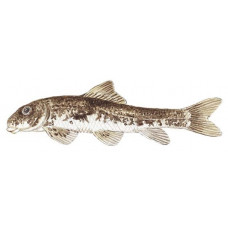Latin name
Hypentelium nigricans
Other names
Sucker, hog sucker.
Identification
The Northern Hogsucker gets its name from its pig-like appearance, especially its head. It has a very steep forehead and long, protruding lips that strongly resemble a pig's snout. The head also has a concave indentation between the eyes, which is characteristic of suckers. The body is conical in shape, with the head much thicker than the tail. The body has four lateral bands that converge on the back of the fish to form a saddle. Northern suckers are usually darkly pigmented on the back and lightly pigmented on the belly.
Distribution
The northern hogsucker is widespread in central and eastern North America, occurring in the Great Lakes, Mississippi, Ohio, and some waters of the Atlantic Ocean.
Habitat
The northern hogsucker lives mostly in large streams and small rivers. It is usually found in places with high water quality and clean substrate without heavy siltation. It leads a benthic lifestyle, staying near the bottom in places with varying depths and current velocities. Adults may live in deep pools and channels because they are too large to be preyed upon by bass and other predators. Juveniles and fry live in faster moving water and along the edges of streams.
Size
The Northern Hogsucker is a medium sized sucker, reaching 12-14 inches in length. Sexual maturity occurs at 2 to 3 years of age, although most fish do not spawn until 4 years of age. Can live up to 8 years.
Life history and Behavior
Northern hogsuckers spawn in mid to late spring as the water begins to warm. They do not make long upstream migrations like many suckers, but rather spawn in pool tails, on rivers, and along the edges of streams near their habitat. Like most suckers, they require clean gravel substrate for successful reproduction.
Food and feeding habits
Like most suckers, the northern hogsucker feeds on many types of bottom-dwelling organisms, most commonly insect larvae, small crustaceans, detritus, and algae. It feeds by disturbing the stream bottom with its large snout and sucking up the organisms it displaces. It can often be seen feeding near large rocks with its body tilted upward and its tail held high, almost perpendicular to the bottom of the stream. Its small air bladder and large pectoral fins help it stay in the current while feeding.
Reproduction
No information
| Classification | |
| Phylum | Chordata |
| Class | Actinopterygii |
| Squad | Cypriniformes |
| Family | Catostomidae |
| Genus | Hypentelium |
| Species | H. nigricans |
| Features | |
| Conservation status | Least Concern |
| Habitat | Bottom |
| Life span, years | 8 |
| Maximum body weight, kg | 0,79 |
| Maximum length, cm | No information |
| Sailing speed, m/s | No information |
| Threat to people | No information |
| Way of eating | Bentophage |

